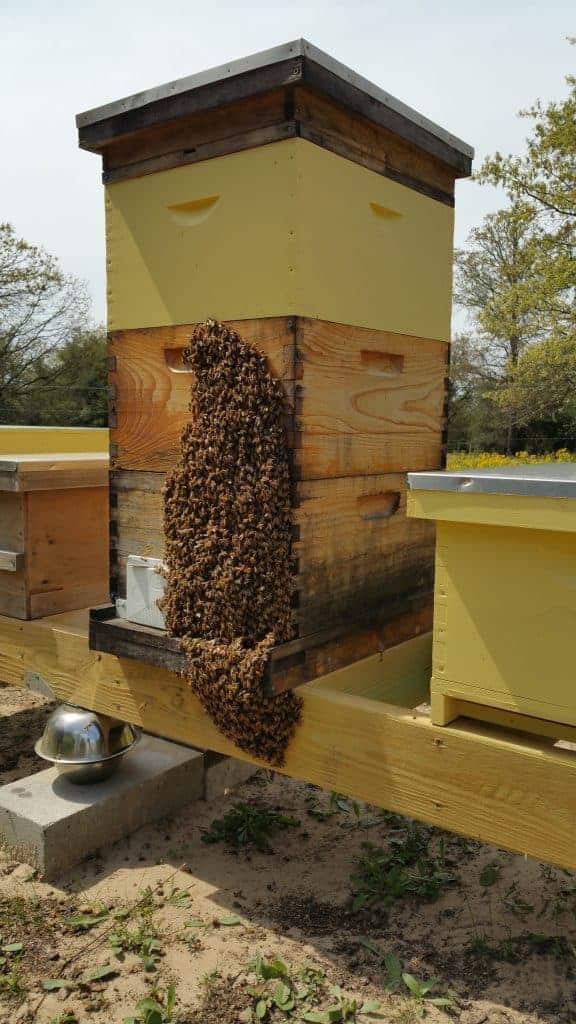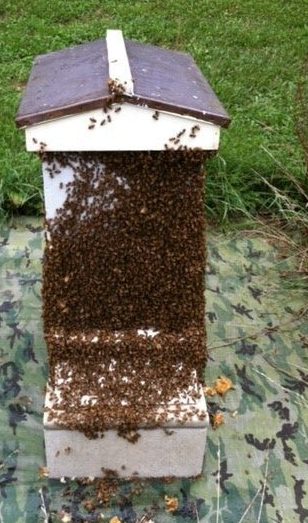From foraging to reproduction to making honey, beekeepers find joy in watching bees exhibit all their behaviors. The reasons for many of these behaviors are quite clear. For example, we smile at the industry of the worker bee flapping her wings to help regulate the temperature of the hive. But there are some behaviors that can leave us scratching our heads. For the new beekeeper, one example is “bearding”.
The first time a beekeeper observes bearding he or she may be concerned that the colony is about to swarm. It can be a worrying situation, with so many bees supposedly uncomfortable with life inside the hive.
In fact, while bearding can sometimes be the precursor to swarming, in most cases it’s a perfectly benign and effective behavior by our bees, associated with hot weather.
In this lesson, we’ll look at bearding, why it happens, and whether there’s any cause for concern.

What does bearding look like?
When bearding occurs, bees gather in significant numbers outside the hive, generally near the entrance. The precise form this takes can vary, but the name clearly comes from the sense that the hive has a “beard”! We beekeepers can get creative with our terminology!
Bearding may appear in various guises.
- A thin layer of bees extending upwards from the entrance, on the front of the hive.
- Tight bunches of bees, in layered groups near the entrance.
- Groups of bees across the landing board
- A sheet of bees at the bottom of the hive
The bees may be largely static or they might be fanning the hive like crazy!
In short, bearding takes many forms and none of these, in themselves, indicate a bad situation.
Why do bees beard?
While it is true that bearding can sometimes occur before bees swarm, the more common scenario involves no intention of swarming. In this situation, bearding behavior is simply a response to high temperatures in the hive.
When conditions get hot in a hive, bees have a number of options. One of the most straightforward is simply to reduce the number of bees inside. So getting bees outside the hive is a perfectly good response and those bees need somewhere to go. Always preferring a simple, easy answer, our bees may simply congregate outside the hive on the outside walls – and we see bearding.
Another common reaction to help regulate internal conditions is the fanning of wings, pushing air into (and possibly out of) the hive. In fact, bees may gather at opposite hive entrances, with one group pushing air into the hive and others extracting air. This takes the form of workers on the landing board fanning their wings.
By the way, this is one of the rare situations where drones can also lift a metaphorical finger and help out! So, it’s not true to say that the “chaps” in the hive have only one thing on their mind (procreation). They may also help with the ventilation effort!
Though the collective fanning effort can be observed when there is no bearding, it’s common to see bees fanning their wings when bearding occurs.

Bearding vs. Swarming
While bearding itself is a common scenario to help maintain acceptable conditions in the hive, it can sometimes be a forewarning of an intent to swarm. That begs the question, of course, as to how a beekeeper can tell the difference.
One of the most valuable tools we have, as beekeepers, is a keen awareness of local conditions and particularly the normal behaviors of each our of colonies. Time taken to observe and note the changes in the behavior of our bees is valuable in helping us understand when something is afoot. For example, in a hot climate and/or a large colony, bearding may be quite common as the primary way they regulate temperature. Over time a beekeeper can come to recognize this simply as part of a colony’s gameplan!
But sometimes what seems like bearding may, in fact, signal more. Bearding may also occur as bees are preparing to swarm. To help understand this, it’s instructive to consider what bees do when they swarm.
Gorging Bees
Swarming bees fill themselves with honey before they leave. Their next meal after swarming is less than certain, so the gorging of honey is an important step. Extrapolating that to bearding-before-swarming, these bees will be somewhat lethargic, due to their full stomachs.
Presence of Scout Bees
But while these full-and-bearding bees may be slow and calm on the outside of the hive, there may be intense activity around the hive. This may be scout bees, out and about to locate the initial landing place for the swarm to rest, returning to the hive to have their “discussion”.
So, while not at all a foolproof method, regular bearding might be differentiated from swarm-driven bearding by the activity of the bees, as well as those returning to the hive.
By comparison, bearding bees tend to simply crawl outside the hive and rest on its outer walls, without becoming airborne.
Time of Year and Time of Day
Like most bee behaviors, there are no hard-and-fast rules on which you can completely rely! However, the time of year and the time of day can offer more clues as to the intent of your bees.
Swarming is most common in mid-to-late spring. Bearding is more aligned with the hotter weather and, as such, can appear later in the summer.
On any particular day…
- Bearding is a reaction to high temperatures and, as such, often occurs later in the day. It may continue until temperatures start to fall, which may be early evening.
- Swarming often occurs in the morning or up until mid-afternoon.
Noise
Another clue is that swarming bees often make a significant noise, whereas bearding bees tend to rest and maintain a low volume.
If you do see activity that suggests your bees may be about to swarm, consider taking action to improve their situation. This is commonly a lack of space (add a box), an overheating environment (ditto), and so on.
Check out the Academy lesson Recognizing and Avoiding Swarms for more details.
Bearding and the honey flow
Another bearding-related factor is whether there is ready access to nectar and pollen. During the honey flow your workers are going to be all out to make the most of what is around them! With so much opportunity, there is less time to rest and bearding is less likely.
During a nectar dearth, however, there’s less to fetch and bearding is more likely.
What to do when you see Bearding
The sight of bearding might seem dramatic, at least the first time you see it. But the best course of action is quite possibly…to do nothing.
Bearding can last for a few minutes or, in some cases, over many days. If your bees are doing so simply to regulate conditions in an otherwise acceptable hive then there is generally nothing to worry about. In this situation, you can just enjoy the sight of your bees exhibiting this fascinating behavior. They are doing their job, very well.
On the other hand, when things are a little too “cozy” in the hive, the collective may be considering more dramatic action. Always be aware of whether the capacity of the hive is sufficient for your bees. Bearding is triggered by higher temperatures in the hive and one factor there is the “per bee” space available. Adding another box into which the colony can expand can alleviate that pressure.
Alongside this important and ongoing assessment of hive capacity, also be aware of the impact of the sun on the hive. The position of the hive is important, both by ensuring there is adequate airflow around the hive as well as shade. A well-positioned hive allows plenty of sun on the hive (preferably early in the day) but provides a little respite later in the day with some shade from trees.
